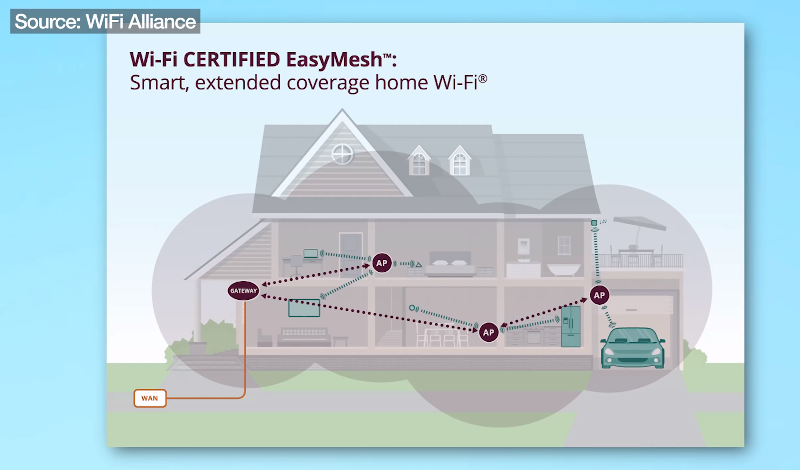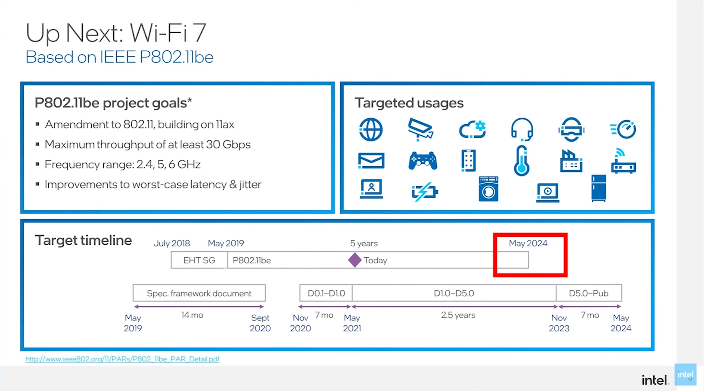Here I have three really interesting updates or developments, whatever you want to call it, with Wi-Fi that you'll probably see soon? And I would consider this very important.
What are the new big updates coming to WIFI?
The first one is called Wi-Fi HaLow, and it allows a much longer range for IoT devices. The second development is called EasyMesh, and that makes it a lot easier to have mesh networks.
You might know those. And the third one is Wi-Fi 7. Yes, we have barely even gotten Wi-Fi 6 out yet, but they're already working on Wi-Fi 7, and it could come relatively soon.
What is WiFi HaLow?
And the first thing I'm going to talk about is WiFi HaLow. It's spelled H-a-L-o-w, and it's just the name for a new spectrum for Wi-Fi that is sub-1 GHz.
 |
| Source: @Wifi Alliance |
So you may know there's the 2.4, there's the 5GHz, there's the upcoming 6-7GHz, and now there will also be a lower, 1 GHz. And the idea is it'll be for IoT devices mainly.
So not big, heavy bandwidth main computers or phones and stuff like that. More like smart home devices or really anything you consider the Internet of Things. Just stuff that doesn't require a lot of bandwidth, but would greatly benefit from better connection and longer range.
 |
| Source: @Wifi Alliance |
And the benefit of sub-1 GHz is the lower the frequency of a radio wave, the longer it can propagate, and the more it can pass through obstacles. And the usable range they've said for this sub-1GHz spectrum is around a kilometer.
If there are no obstructions not nearly that far if there are obstructions. But still going to be way longer than what you're going to get with 2.4 even.
 |
| Source: @ThioJoe |
Now, the actual frequency range specification for HaLow is 750 MHz to 928 MHz. However, not all of that is going to be used in every country.
Like most countries, only part of that is going to be used for Wi-Fi. But still, it's better to have it. And then depending on what country you're in, that's what your device will use.
And each channel of this sub-1GHz spectrum could be as narrow as 1 MHz. So that means that say, your country only has 20 MHz allowed for the sub-1GHz for WiFi.
Well, you'll still have 20 channels, that device can use simultaneously, and that'll mean a lot less interference. And the way the specification works is, it supports at least 8191 devices, and I believe even more if it's on the narrower MHz bandwidth.
Now, as I said, speed is not the priority here. It's not going to be for streaming video or anything.
It's more for devices that don't need a lot of bandwidth, like smart lights or something like that. It doesn't take almost any bandwidth to be able to get the signal, "turn on this color" stuff like that.
And from what I've read, the speed on a narrowest 1 MHz channel could be anywhere from 150 Kbps, not much at all, up to 4 Mbps per second, which is actually kind of decent if you're talking about a kilometer away, and that's going to depend on what "MCS" you're using its so-called, Modular coding scheme.
However, devices could combine multiple channels and use more than 1 MHz width, and also for each channel I believe, use up to four spatial streams.
I'm not going to get into all that, but just means it can combine signals, and it can get up to 80 Megabits speed absolute maximum. Although that would probably mean that there would have to be a lot less interference from any devices if that was the case.
Another benefit is this HaLow protocol would require much less power usage. It can allow devices to sleep and only send signals very infrequently. And apparently, it would allow devices to run off a single-button cell battery for months or even years.
Now, this standard was published way back in 2017, but it's only until now that it's kind of gotten attention and started to become a thing.
And that part is because the Wi-Fi Alliance, which kind of manages the Wi-Fi standards, actually created a certification program for Wi-Fi HaLow. So now it'll be a little bit more standardized. Hopefully,
it's going to be rolled out on more devices, and it won't just kind of be left by the wayside.
What is Wi-Fi EasyMesh?
The next development is the so-called Wi-Fi EasyMesh Specification and certification program. Now, if you're not familiar, a Wi-Fi mesh network is not new.
 |
| Source: @Wifi Alliance |
It's been around for years and allows you to combine multiple Wi-Fi access points.
And allow a phone or device to kind of see them all as the same thing so it can swap between the closest access point, whichever has the best signal without the user having to manually go in and switch to an extender or something like, that that has a different SSID.
So it's a way more convenient way to set up a Wi-Fi network, though it is a little bit more expensive, and plenty of manufacturers have created their Wi-Fi mesh routers and networks.
But the problem is different mesh access points from different manufacturers are not going to usually work together.
However, that certification program will change this because now going forward, if the manufacturers want to follow this standard, they'll have to make their products in a way that will make them inter-compatible.
So say you buy a Linksys mesh network, you might be able to go buy and Netgear access point to add on to it. Because maybe that one's cheaper and it works fine and you don't have to buy the super expensive one.
Or maybe you buy the expensive ones for your main ones, and then again a cheaper one for some corner of your house, that sort of thing.
And apparently, the EasyMesh specification will also be backward compatible with Wi-Fi 4, 5, and 6. So you could buy a, maybe cheaper router that only supports Wi-Fi 5 or something like that, but it would still be able to do the mesh.
Or if you have a device that only supports an older version, you could use it on the mesh network still. So again, I think this development is also really awesome. It's going to make mesh networks a lot more affordable I think, and easier to expand.
What is Wi-Fi 7?
now finally we can talk about Wi-Fi 7. Yes, you might not even have Wi-Fi 6 or 6E yet, but they're already working on Wi-Fi 7.
And according to a webinar that was hosted by the CTO of Wireless Connectivity at Intel, he speculated that we could have Wi-Fi 7 within three years, which is a lot shorter than the usual 6 years between generations.
 |
| Source: @Intel Technology |
And supposedly Wi-Fi 7 would be possibly capable of speeds of around five times what Wi-Fi 6 is. Meaning it would be around 46 Gigabits per second max.
 |
| Source: @Intel Technology |
And the reason for this is it would be capable of something called multi-link operation or MLO, which would allow devices to connect to multiple channels simultaneously.
 |
| Source: @Intel Technology |
Now I'm not talking about channel bonding, where you kind of combine it wider, but I also mean, you could connect to, for example, both a 5 GHz and a 6 GHz on completely different spectrums, which you can't do right now.
Also, the Wi-Fi 7 specification would include that sub-1GHz spectrum of Wi-Fi HaLow, as well as the 6-7 GHz spectrum of Wi-Fi 6E. So it's kind of like the best of all worlds.
Now I mentioned connecting to multiple channels before, but this will also allow you to combine channels into bigger ones.
So currently, the maximum is 160 MHz wide channels.
Now, you'd be able to go up to 320. And one interesting thing that's being worked on with Wi-Fi 7 is something called OpenRoaming,
where it's an industry initiative were a lot of big companies like supermarkets, that sort of thing, target, Walmart, whatever is working on creating a, effectively a network of Wi-Fi that would be as accessible and seamless as cellular networks.
So potentially, I don't know how would work, but potentially you could maybe I don't know, sign up and pay for some kind of subscription. And if you were to go in the range of one of these hotspots, then it would automatically connect you and maybe have the faster speed or something like that.
Now you might be thinking, wait a minute, aren't public Wi-Fi hotspots, not a good thing to connect to? And for the most part, yes.
However, with Wi-Fi 7 and a specific feature WPA3, which is the latest security protocol for Wi-Fi, there's an optional feature called Wi-Fi Enhanced Open,
which fixes all the old issues of connecting to a public Wi-Fi hotspot where if one person connects, then there was the same encryption key used for everyone that's connected so that one person connects and can decrypt all the traffic from everyone else.
Assuming they weren't using HTTPS or something, which most things do. But with Wi-Fi Enhanced Open, it is an optional feature, but presumably, any public Wi-Fi hotspot would be using it.
Allows every single device that's connected to have a separate encryption key. So no matter how many people are connected to it, they can't spy on other people's connections.
So you just have to trust the Wi-Fi hotspot itself, and not everyone else connected to it, which is a big improvement. Who knows if that will pan out. It's just something to keep an eye on.

















